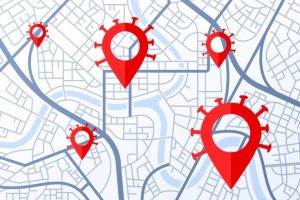
The following was originally published in The Hub.
Since a team of Hopkins researchers launched the COVID Control app 11 months ago, more than 19,000 users in 1,019 counties in every state across the U.S. have used it to create more than 174,000 data entries.
The goal of the app and its study is to leverage information about novel coronavirus symptoms reported anonymously by users to allow public health and government officials to detect potential outbreaks of COVID-19—and take action—before they happen.
Available via both Google Plus and Apple’s App Store, COVID Control tracks symptoms such as fever, loss of taste/smell, nausea, and others, and provides a publicly viewable map showing the locations of clusters of those suffering from COVID-19 symptoms. A paper reporting the study’s findings was recently published in Nature Scientific Reports.
“Our work highlights the use of volunteered geographic information to address urgent public health threats, while our dashboard allows our users and the general public to view the analytics, which are updated daily,” said Michael Desjardins, a postdoctoral fellow at the Bloomberg School of Public Health and one of the COVID Control team members. “So, instead of collecting data for research purposes only, we’ve developed an automated system to provide results and important information back to the users, especially spikes in COVID-19 symptoms.”
Less than a year into launch, the study team has hit many of its goals: accurately mapping COVID-like symptoms in space and time, reflecting in quasi-real-time the health status of the sampled population, and creating an app that is broadly accessible and easy to use while also widely disseminating findings through the COVID Control map.
The research team concluded that though all reported symptoms were important to track, the loss of taste and smell ended up as the most indicative of a coming cluster.
“Loss of taste and smell was most predictive because those symptoms turned out to be most specific to COVID-19,” Desjardins said. “Studies have shown that up to 85% of symptomatic individuals may experience new loss of taste and smell, especially in mild-to-moderate cases. We expect that more data will increase the strength of associations between other symptoms, such as fever.”
The COVID Control group comprises engineers, epidemiologists, and physicians from Johns Hopkins’ Whiting School of Engineering, Bloomberg School of Public Health, and School of Medicine. Ralph Etienne-Cummings, a professor in the Department of Electrical and Computer Engineering; Frank C. Curriero, a professor in the Department of Epidemiology and director of the Spatial Science for Public Health Center; and Robert Stevens, an associate professor and director of precision medicine in the Department of Anesthesiology and Critical Care Medicine, are part of the team.
The system’s development was done by Amparo Güemes, Soumyajit Ray, Khaled Aboumerhi, and John Rattray (doctoral candidates from Etienne-Cummings’ lab), with spatial epidemiologists from the Spatial Science for Public Health Center (Desjardins, Timothy Shields, Anton Kvit, Brendan Fries, and Anne Corrigan) providing the data analytics.
To Etienne-Cummings, the interdisciplinary nature of the project makes COVID Control a distinctly “Hopkins venture” and contributes to its success.
“Collaborations like COVID Control are aligned with the strategic plan of the university, divisions, and schools,” Etienne-Cummings said. “I was surprised by how we quickly pooled all our resources, formed a multidivisional team, and tapped into our industrial networks to get the app written and hosted by Google and Apple. We also had to quickly communicate to a large group of potential users at a time when getting a COVID-related app created was difficult. Now we have data with tens of thousands of users that can be mined to learn more about how COVID-19 spread.”
Etienne-Cummings is confident that the app will be even more successful in predicting outbreaks as more users come on board.
When trying to convince people to participate in the study, Ray likens it to people voting in elections: it is not just about the individual but also about doing one’s part for the greater good.
“While a single vote may not determine the outcome, all the votes in an election add up to determine the future direction of our country,” Ray said. “Similarly, every symptom reported increases the statistical power of our analysis and leads to better decisions. It ultimately translates to how many people we can save and how soon we can go back to our normal lives.”